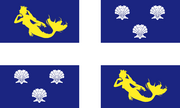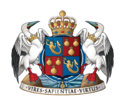La Navasse
The Principality of the Navasse La Principauté de la Navasse | |
|---|---|
| Motto: ‘Vires Sapientiae Virtus’ (Latin: "Strength, Wisdom, Virtue") | |
| Anthem: La Marche Princière | |
| Capital | Cap-Paradis |
| Official languages | English, French, Haitian Creole |
| Demonym(s) | Navassian |
| Government | Semi-Constitutional Monarchy |
• H.S.H. The Sovereign Princess | Marie-Adélina I |
| Legislature | General Assembly |
| Establishment | 13 September 2017 |
| Currency | Navar (N£) |
Website Official Website | |
The Navasse (La Navasse), officially the Principality of the Navasse (French: Principauté de la Navasse; Haitian Creole: Prensipale nan Lanavaz), is a micronation founded in 2017. It draws inspiration from the history and legacy of the Kingdom of Haiti and claims the uninhabited Caribbean islands of Navassa, Serranilla Bank, and Bajo Nuevo Bank.
The micronation operates with a structured government, including a monarchy led by Princess Marie-Adélina I. The governance includes various secretariats that function similarly to government departments, and the nation has its own constitution. The Princely House of Navasse claims descent from Henry Christophe, a historical figure in Haiti.
Navasse is a member of La Microfrancophonie, an organization of French-speaking micronations, joining in 2019.
The micronation celebrates several holidays, including New Year's Day, Women's Day, Pride Day, and Founding Day, among others, in addition to its own currency, the Navar (N£; NVR).
History
The earliest record of Navasse comes from 1504 when Christopher Columbus inadvertently discovered the island. Lacking drinkable water, his men named the island Navaza or plain and avoided the island for centuries.
With the signing of the Treaty of Ryswick in 1697, the island was transferred to France. It would remain part of the French territory of Saint-Domingue until the proclamation of Haïti on January 1, 1804. Several months after his coronation, revolutionary hero Emperor Jean-Jacques Dessalines rewarded the title Duc de la Navasse to Henry Christophe - at least, according to family legend. But after the assassination of Jean-Jacques I in 1806, Christophe and his followers traveled to the northern part of Haïti and established a separate government. In 1807, Henry was proclaimed President & Generalissimo of the State (northern) of Haïti. Four years later, he proclaimed himself King of Haïti and was crowned by Corneille Brelle, who had previously crowned Dessalines himself. Though Haïti was divided between the royal north and republican south, Henry I proclaimed himself ruler “of Tortuga, Gonâve, and other adjacent islands” - including Navasse.
King Henry sought to create a royal court on par with his European counterparts. From his Sans-Souci Palace in Milot, near the royal capital of Cap-Henry - now Cap-Haïtien - Henry was an ardent supporter of science and the arts. He established a cabinet government and nobility modeled after the British and ordered regalia from London to reinforce his majesty. Henry later created a codified constitution, the Code Henry, which promoted education and freedoms - though the King held most of the power.
A stroke in the summer of 1820, added to growing discontent fuelled by instigators from the republican South, brought the fall of King Henry’s reign that year. His family relocated to the Citadelle Laferrière, a fortification built to protect the kingdom from a purported French invasion. Refusing to see himself fall into the hands of his enemies, Henry shot himself on October 8, 1820. His son, the Prince Royal Victor-Henry - briefly recognized as King Henry II - was stabbed by insurgents ten days later. Henry I’s wife, Queen Marie-Louise, and daughters Princess Françoise-Améthyste and Princess Anne-Athénaïre left in exile to Europe, where they died in Italy.
Navasse changed hands but remained forever under the flag of Haïti. That is, until the mid-1800s. The U.S. Guano Islands Act of 1856 gave American citizens the right to take possession of uninhabited islands containing guano deposits. A year later, American sea captain Peter Duncan claimed the island - despite its longstanding claim by Haïti. Two years later, President James Buchanan issued an Executive Order upholding the claim - a decree still in effect today.
It is believed Henry I bequeathed the title of Princesse de la Navasse to his legitimized daughter, S.A.S. Princess Blésine Georges Christophe, who married Count Nord Alexis in 1819. Her son, Pierre Nord Alexis, was born in Cap-Henry in 1820. Eventually becoming the 2nd Prince de la Navasse, Pierre spent his life in public service, serving as a provincial governor under Emperor Faustin I, who recognized the title, followed by a stint as a war minister and a provisional government member in the country's northern part in 1869-70. Finally, in 1902, Pierre was elected President of Haïti. Remembering the stories of his late grandfather, he, too, dreamt of the days of the return of the Monarchy. He proclaimed himself President for Life in January 1908 and proposed a constitutional monarchy but was greatly opposed and forced into exile by the end of the year.
After Pierre died in 1910, the title fell into abeyance until Pierre’s great-great-great-granddaughter, Marie-Adélina, assumed the title and throne of Navasse on September 13, 2017. Claiming the uninhabited islands of Navassa, Serranilla Bank and Bajo Nuevo Bank, the three islands would form the basis of this small but proud micronation.
Government and Politics
The Princess holds absolute authority per the Constitution that governs Navasse. As Sovereign, she is supported by the Privy Council, a body of counsellors that provides advice on policies, activities and other engagements, to which the Sovereign gives or withholds Assent.
The Chancellery of the Navasse (Chancellerie de la Navasse) is the central royal governing bureaucracy that aids in the daily operation of The Crown, with each department (secrétariats) overseeing specific political function. Its current secretariats include:
- Secretariat of State (Secrétariat d'État/Sekretarya deta) is the foremost department in the Principality of the Navasse, dedicated to executing the micronation's internal policies. This distinguished entity is responsible for creating and preparing official decrees and has a significant supervisory function across multiple policy sectors, especially in cybersecurity intelligence and citizenship issues. It oversees a wide range of domestic areas, guaranteeing efficient and seamless management of the nation's internal governance.
- Secretariat of Foreign Affairs (Secrétariat des Affaires Étrangères/Sekretarya Zafè Etranje) is tasked with the stewardship of diplomatic engagements with foreign governments. Its core responsibilities encompass the orchestration of dialogues and negotiations with governmental bodies of these entities, alongside providing counsel on the formulation of treaties aimed at fostering friendship and collaboration. This department serves as the linchpin in establishing and nurturing cooperative ties with various micronations, micro-national consortia, and macronational states, ensuring a harmonious and constructive international diplomatic landscape.
- Secretariat of the Exchequer (Secrétariat de l'Échiquier/Sekretaria Echikè) is tasked with the crucial roles of collecting and administering financial resources for government-funded projects and initiatives. This entity is not only responsible for managing incoming funds but also oversees the disbursement of payments on behalf of the monarch. Additionally, it plays a key role in supervising the Treasury of the Exchequer, which serves as the principal bank account for The Crown, ensuring the effective and efficient handling of the state's fiscal affairs.
- Secretariat of Community Affairs (Secrétariat des Affaires Communautaires/Sekretarya Afè Kominotè) serves as a pivotal bridge between the chancellery and the local communities, playing a crucial role in fostering collaborative relationships and ensuring the voices of the community are heard and acted upon. This secretariat is tasked with the critical responsibility of identifying, engaging, and partnering with community-focused organizations that are aligned with Navasse's key policies and mission to enhance the well-being and prosperity of local populations.
Economy
Navasse’s command economy is notable for supporting Haitian-based products, sold in its domestic market and exported primarily to the U.S. market. In addition, the Crown authorizes a partial donation of annual funds to community-focused organizations.
Navasse's official currency is the Navar (N£; NVR), with a conversion rate of 1 NVR = .1 USD.
Culture
The culture of Navasse is a vibrant and unique amalgamation of Haitian, Caribbean, and British influences. This cultural fusion is primarily derived from the historical connection between Navasse and Haiti. This influence can be traced back to the Royal Family's roots to the country. The culture of the Court of King Henry Christophe of Haiti, which flourished during the early 19th century, plays a significant role as the ancestor of the Royal House. King Henry Christophe was a key figure in Haitian history, known for his ambitious architectural projects and his efforts to promote Haitian art and culture. The court under his reign became a center for the arts, literature, and music, and it had a lasting impact on the cultural development of the region. Navasse's cultural expression is a vibrant tapestry of various artistic expressions.
Music and visual arts form an integral part of the cultural heritage. Radio Lanavaz plays traditional Haitian music, such as compas, zouk, and mizik rasin, along with other Latin American and Caribbean influences. Classical music is also richly celebrated, with the legacy of Haitian composers such as Ludovic Lamothe, Julio Rancine, Werner Anton Jaegerhuber influencing the court's music taste.
Cuisine is another important aspect, with the rich blend of African, French, and indigenous influences bringing the best to the table. Staple dishes such as rice and beans, plantains, and seafood delicacies showcase the fusion of flavors that reflect the diverse cultural heritage.
The primary language spoken is English. However, due to the strong Haitian influence, French and Haitian Creole are also spoken and serves as a significant mode of communication.
Holidays
New Year’s Day (1 January), Feast of La Sirène (2 February), Women’s Day (8 March), Culture Day (25 March), Princess' Day (16 May), Environment Day (5 June), Pride Day (24 August), Founding Day (13 September) King Henri's Birthday (6 October), and Ancestors' Day (2 November). In addition, the Princely Court goes into three recess periods throughout the year - Spring, Summer, and Winter.

